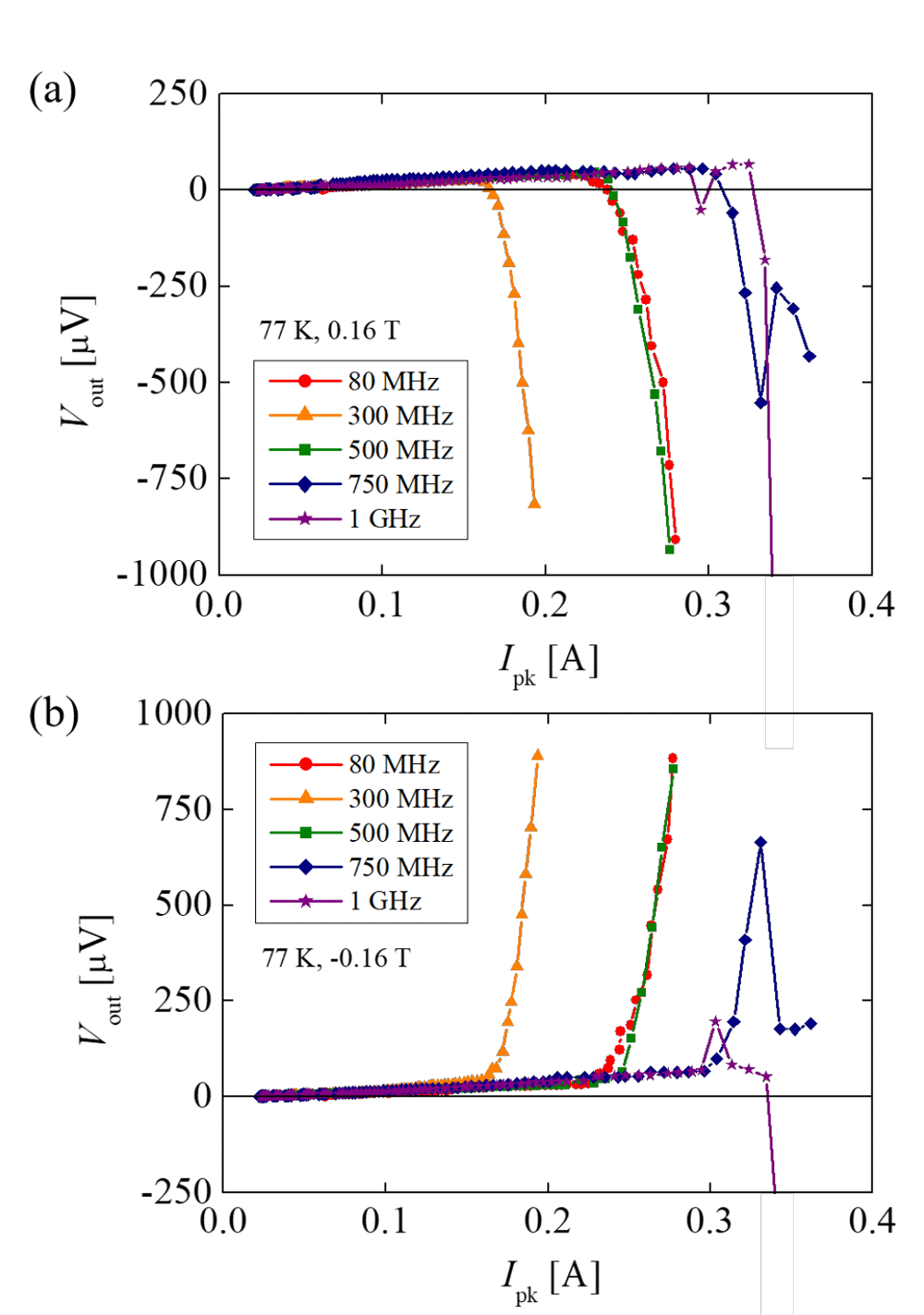ED-2-1-INV
Rectification of RF signals using REBCO high-temperature superconducting diodes
13:15-13:45 28/11/2023
*Y. Tsuchiya1, A. Mizuno2, A. Tsuruta3, T. Ozaki4, Y. Yoshida2, and S. Awaji1
1. High Field Laboratory for Superconducting Materials, Institute for Materials Research, Tohoku University, Sendai 980-8577, Japan
2. Department of Electrical Engineering, Nagoya University, Aichi 464-8603, Japan
3. National Institute of Advanced Industrial Science and Technology (AIST), Nagoya 463-8560, Japan
4. Kwansei Gakuin University, Hyogo 669-1337, Japan
A superconductor with a critical current depending on the direction of the current is called a superconducting diode. This device is realized by asymmetric potentials for flux quantum in superconductors and has the potential to be used as an efficient rectifier in cryogenic conditions [1]. Recently, other types of superconducting diodes using the Rashba effect or the Josephson diode effect in junction systems have also been reported [2,3]. The superconducting diodes are expected to be used for the ultra-long distance power transmission using microwaves. In addition, the superconducting diodes also have the potential to be used for the wireless charger operated at cryogenic temperatures for the superconducting magnets. It is necessary to confirm the rectification effect in the device for RF signals in the microwave band with frequencies above several 100 MHz. We have reported the superconducting diode effect in the high-temperature superconducting REBa2Cu3Oy (RE = rare-earth elements including Y element, REBCO) films when a magnetic field is applied along thea,b-plane [4]. This diode effect is caused by a surface barrier for flux quanta; it is controlled by epitaxial strain and surface roughness [5].
In this study, we fabricated high-temperature superconducting REBCO films as the superconducting diodes and measured the rectification effect on RF input signals in the microwave frequency band. We fabricated Ba2Cu3Oy (YBCO) films on the metal templates with and without a buffer layer of non-superconducting PrBa2Cu3Oy (PrBCO) films by a pulse laser deposition using a KrF excimer laser with a wavelength of 248 nm. The former sample had a 450 nm-thick YBCO film deposited on a CeO2-buffered IBAD-MgO substrate without a PrBCO buffer layer. The latter has a 450 nm-thick YBCO film with a 50 nm-thick PrBCO buffer layer. PrBCO is non-superconducting and has a lattice structure close to that of YBCO. The lattice mismatch of YBCO with PrBCO is 1.09% in the a-axis and 0.74% in the b-axis direction. This mismatch is small compared to one of YBCO with CeO2 (0.09% in the a-axis direction and 1.60% in the b-axis direction. Using another pulsed laser, the thin films were processed into 100 µm and 1 mm long wide bridges. The sample was cooled to 77 K by cryocooler conduction cooling and an in-plane magnetic field of -5 to 5 T was applied by a superconducting magnet. The RF signal was transmitted through the sample via a microstrip line. The RF input signal from 80 MHz to 1 GHz was generated by an RF signal generator and RF power amplifier and had the power of up to 44 dBm. The RF input signal was passed through the sample and then the peak current of the signal transmitted through the sample was calculated to be equivalent up to 0.64 A from the measured values of a terminating power meter with a characteristic impedance of 50 Ω. The DC output voltage which is rectified at the sample was measured with a nanovolt meter through a 160 kHz low-pass filter.
As a result, DC output voltages appears at 77 K under various in-plane magnetic fields at various frequencies up to 1 GHz, the maximum frequency in the measurement range. Figure 1 shows the input current amplitude dependence of the output DC voltage at 77 K and 0.16 T. The DC output signals appeared from a current amplitude of about the current amplitude reaching the critical current such as 0.2 A and increases as the input signal increases, with the voltage dramatically increasing due to thermal runaway at an output of about 1 mV. The output DC voltage was inverted with respect to the magnetic field inversion. The inversion of the output signal with respect to the magnetic field direction indicates that the DC output is not a thermoelectromotive force, but that the RF input signal was rectified by the superconducting diode. Referring to the frequency dependence, the peak current at which 100 µV output was obtained varied between 0.2-0.3 A from 80 MHz to 1 GHz, with a minimum value at 300 MHz. On site, we will introduce the origin of the superconducting diodes, optimization of the diode effect, and the RF measurement equipment.
[1] X. Jiang et al., Phys. Rev. B 49, 9244 (1994).
[2] R. Wakatsuki et al., Sci. Adv. 3, e1602390 (2017).
[3] H. Wu, et al. Nature 604, 653–656 (2022).
[4] Y. Tsuchiya et al., TEION KOGAKU, 57, 349 (2022).
[5] A. Mizuno et al., IEEE Trans. Appl. Supercond. 32, 6601005 (2022).
This work was partly supported by JSPS KAKENHI Grant Number 20K15217, 22H01522, 22KK0244, and NEDO JPNP14004, JPNP20004, and NU-AIST alliance project. We are grateful to Y. Iijima for providing us with metal templates, T. Hatano for help in the sample setup, Y. Ichino for useful discussions on the sample preparation, S. Ohshima, A. Maeda, I. Kakeya, T. Nojima, S. Hara, N. Kokubo, for useful discussions on the measurements.
